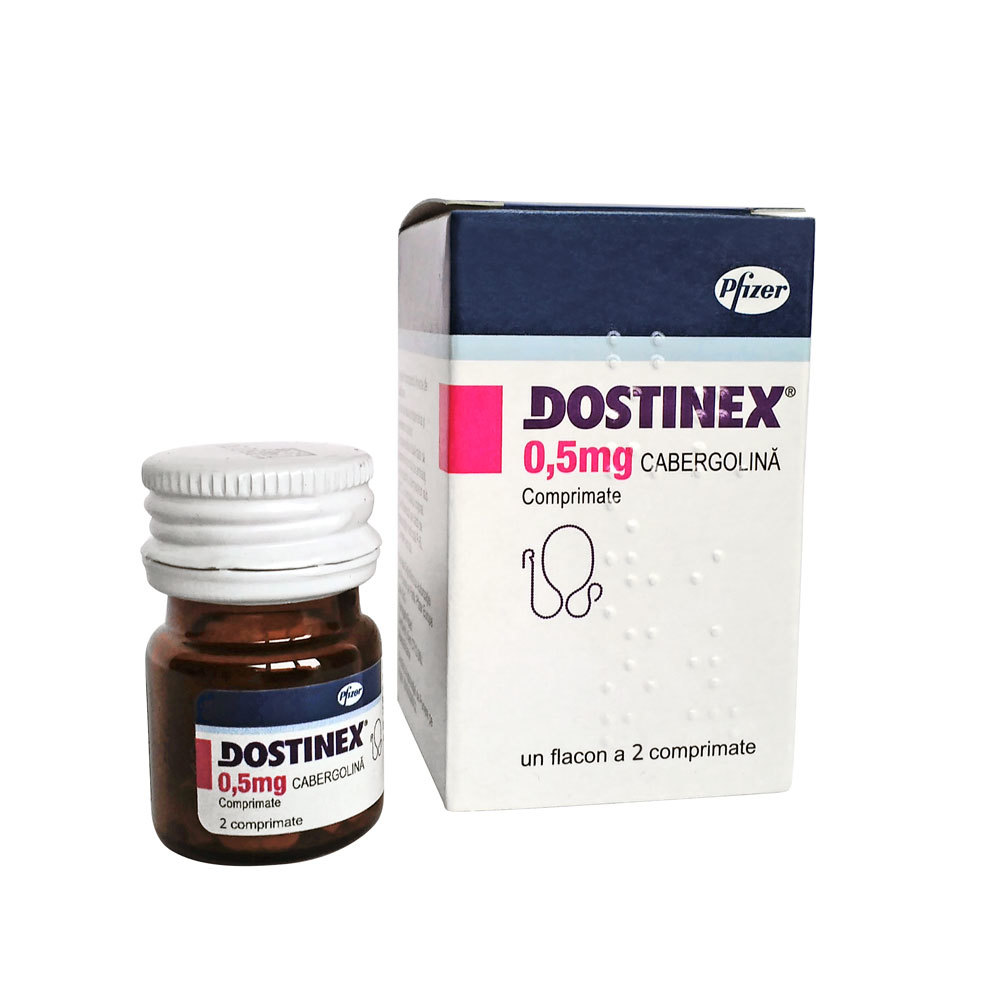
Dr. Ashwini
21-04-2025
Dostinex for Men: How It Treats High Prolactin and Low Testosterone
When men experience symptoms like low libido, fatigue, erectile dysfunction, or even breast enlargement, the culprit is often an overlooked hormonal imbalance high prolactin levels. This condition, known as hyperprolactinemia, can suppress testosterone production, impacting physical and emotional well-being. Dostinex (Cabergoline), a powerful prescription medication, is a trusted solution for men with high prolactin, helping restore hormonal balance and alleviate symptoms. In this blog, we’ll explore how Dostinex works for men, its benefits in treating high prolactin and low testosterone, proper usage, potential side effects, and key considerations to determine if it’s right for you in 2025.
Understanding High Prolactin and Low Testosterone in Men
Prolactin is a hormone primarily associated with lactation in women, but it’s also present in men, where it plays a role in regulating the immune system and metabolism. When prolactin levels rise abnormally due to conditions like prolactinomas (benign pituitary tumors), medications, stress, or thyroid issues it can disrupt the body’s hormonal harmony, particularly by suppressing testosterone production. This leads to a cascade of symptoms that can affect men’s health and quality of life.
Common Symptoms of High Prolactin in Men:
-
Low libido or sexual desire
-
Erectile dysfunction (ED)
-
Infertility due to reduced sperm production
-
Gynecomastia (breast enlargement or tenderness)
-
Fatigue and low energy
-
Mood changes, such as depression or irritability
-
Loss of muscle mass or strength

The Link to Low Testosterone:
Elevated prolactin suppresses the hypothalamus's release of gonadotropin-releasing hormone (GnRH), which lowers the synthesis of follicle-stimulating hormone (FSH) and luteinizing hormone (LH). In order to stimulate the testes to produce sperm and testosterone, these hormones are necessary. As a result, elevated prolactin often leads to hypogonadism (low testosterone), compounding symptoms like low energy, sexual dysfunction, and reduced vitality.
Dostinex steps in to address this root cause by lowering prolactin levels, which can help restore testosterone production and reverse these symptoms, offering men a path to renewed health.
What Is Dostinex?
Dostinex is a brand-name medication containing Cabergoline, a dopamine agonist that inhibits prolactin secretion. Manufactured by Pfizer, it’s primarily used to treat hyperprolactinemia and prolactinomas in both men and women. In men, Dostinex is prescribed to normalize prolactin levels, which can alleviate symptoms of high prolactin and indirectly boost testosterone by removing the hormonal suppression.
Unlike other treatments like Bromocriptine, Dostinex is long-acting, requiring less frequent dosing (typically twice weekly), and is often better tolerated, making it a preferred choice for managing prolactin-related disorders.
How Dostinex Works for Men
Dostinex targets the underlying cause of high prolactin through a precise mechanism:
-
Mimics Dopamine: Cabergoline binds to dopamine D2 receptors in the pituitary gland, mimicking the action of dopamine, a neurotransmitter that naturally inhibits prolactin release.
-
Lowers Prolactin Levels: By suppressing prolactin secretion, Dostinex reduces circulating prolactin, relieving its inhibitory effects on the hypothalamic-pituitary-gonadal axis.
-
Restores Testosterone Production: With prolactin normalized, GnRH, LH, and FSH levels recover, stimulating the testes to produce testosterone and improve sperm production.
-
Alleviates Symptoms: Reduced prolactin levels help reverse symptoms like low libido, erectile dysfunction, gynecomastia, and fatigue, while restored testosterone enhances energy, mood, and sexual function.
Onset of Action: Prolactin levels often drop within 2-3 weeks of starting Dostinex, with testosterone levels and symptoms improving over 4-8 weeks, depending on the severity of hyperprolactinemia and individual response.
Benefits of Dostinex for Men
Dostinex offers significant benefits for men with high prolactin and low testosterone, addressing both the hormonal imbalance and its effects:
-
Normalizes Prolactin: Effectively lowers prolactin, treating the root cause of symptoms and preventing complications like prolactinoma growth.
-
Boosts Testosterone: Restores natural testosterone production, improving libido, energy, muscle mass, and mood without the need for testosterone replacement therapy in many cases.
-
Improves Sexual Health: Enhances erectile function and sexual desire, addressing ED and low libido caused by hormonal imbalances.
-
Reduces Gynecomastia: Shrinks breast tissue and relieves tenderness, restoring confidence and physical comfort.
-
Enhances Fertility: Increases sperm count and quality, improving chances of conception for men with infertility due to high prolactin.
-
Convenient Dosing: Requires only 1-2 doses per week, compared to daily medications like Bromocriptine, improving adherence.
-
Well-Tolerated: Generally causes fewer side effects than older dopamine agonists, with a favorable safety profile for most men.
These benefits make Dostinex a powerful tool for men seeking to regain hormonal balance and vitality, particularly when high prolactin is the underlying issue.
Dosage and How to Use Dostinex
Proper use of Dostinex is crucial for effectiveness and safety. Always follow your doctor’s instructions, as dosing is individualized based on prolactin levels and response.
-
Starting Dose: Typically 0.25 mg (half a 0.5 mg tablet) taken twice weekly (e.g., Monday and Thursday). Tablets can be split for precise dosing.
-
Maintenance Dose: Adjusted based on blood tests, usually ranging from 0.25-1 mg twice weekly. Most men achieve normal prolactin levels at 0.5-1 mg per week.
-
How to Take: Swallow with water, with or without food. Taking it with a light meal may reduce nausea in some users.
-
Monitoring: Regular blood tests (every 4-6 weeks initially) check prolactin levels to fine-tune the dose. Hormones such as testosterone can also be tracked.
-
Duration: Treatment may last months to years, depending on the cause (e.g., temporary for medication-induced hyperprolactinemia, longer for prolactinomas). Some men can taper off after prolactinomas shrink.
-
Pro Tip: Set calendar reminders for your twice-weekly doses to stay consistent, and keep a symptom diary to track improvements for discussions with your doctor.

Safety Considerations and Side Effects
Dostinex is generally safe for most men when used as prescribed, but it’s a potent medication that requires caution. Here’s what to know:
Common Side Effects
The majority of adverse effects are minor and go away as the body adapts.
-
Nausea or upset stomach
-
Dizziness or lightheadedness
-
Headache
-
Fatigue or drowsiness
-
Constipation
To minimize dizziness, stand up slowly from sitting or lying positions, and take doses in the evening to sleep through mild side effects.
Rare but Serious Side Effects
Seek immediate medical attention if you experience:
-
Heart Valve Issues: Long-term, high-dose use (rare in hyperprolactinemia treatment) may affect heart valves, causing symptoms like shortness of breath or swelling.
-
Severe Allergic Reactions: Rash, swelling, or difficulty breathing.
-
Psychiatric Effects: Mood changes, hallucinations, or compulsive behaviors (e.g., gambling), though rare.
-
Low Blood Pressure: Fainting or severe dizziness, especially at higher doses.
Contraindications
Do not use Dostinex if you:
-
Are allergic to Cabergoline or ergot derivatives (e.g., pergolide).
-
Have uncontrolled high blood pressure or severe heart disease.
-
Have a history of heart valve disorders or pulmonary fibrosis.
-
Are taking medications that strongly interact (see below).
Drug Interactions
Inform your doctor about all medications and supplements, as Dostinex can interact with:
-
Dopamine Antagonists (e.g., metoclopramide, antipsychotics like risperidone), which can reduce its effectiveness.
-
Macrolide Antibiotics (e.g., erythromycin), which may increase Cabergoline levels, raising side effect risks.
-
Blood Pressure Medications: Dostinex can lower blood pressure, amplifying effects of antihypertensives.
Lifestyle Precautions
-
Alcohol: Moderate alcohol is generally safe, but excessive drinking may worsen dizziness or nausea. Discuss with your doctor.
-
Driving: Avoid driving if you feel dizzy or drowsy after taking Dostinex, especially during the first few doses.
-
Fertility Plans: If planning to conceive, inform your doctor, as normalizing prolactin may restore fertility quickly.
Storage
-
Store at room temperature (15-30°C) in a cool, dry place, away from sunlight and moisture.
-
Keep out of reach of children and pets.
-
Do not use expired tablets or those with damaged packaging.
Is Dostinex Right for You?
Dostinex is an excellent option for men with high prolactin and low testosterone caused by hyperprolactinemia or prolactinomas, but it’s not suitable for everyone. Consider these factors:
-
Diagnosis: Confirm high prolactin via blood tests (normal range: 2-18 ng/mL for men). Symptoms alone aren’t enough, as low testosterone can have other causes (e.g., aging, obesity).
-
Health Conditions: Safe for healthy men or those with mild conditions (e.g., controlled diabetes). Riskier for those with heart valve issues, severe liver disease, or psychiatric disorders.
-
Severity of Symptoms: Effective for mild to severe hyperprolactinemia, but severe cases (e.g., large prolactinomas) may require additional treatments like surgery or radiation.
-
Other Treatments: If Dostinex isn’t suitable, alternatives like Bromocriptine or testosterone therapy (for low testosterone not caused by prolactin) may be considered.
When to Consult a Doctor:
-
Before starting, to confirm hyperprolactinemia via blood tests and imaging (e.g., MRI for prolactinomas).
-
If symptoms persist after 2-3 months, as it may indicate an incorrect dose or another underlying issue.
-
If you experience side effects like chest pain, swelling, or mood changes, which require immediate evaluation.
-
Regularly during treatment, to monitor prolactin, testosterone, and heart health (via echocardiograms for long-term use).
An endocrinologist or urologist can assess whether Dostinex is appropriate and rule out other causes of low testosterone, such as primary hypogonadism or lifestyle factors.

Complementary Lifestyle Changes
To enhance Dostinex’s effectiveness and support hormonal health:
-
Eat a Balanced Diet: Include zinc-rich foods (oysters, nuts) and vitamin B6 (bananas, chickpeas) to support testosterone production.
-
Exercise Regularly: Strength training and cardio (150 minutes weekly) boost testosterone and energy levels.
-
Manage Stress: Chronic stress raises prolactin. Try meditation or yoga for 10 minutes daily to lower cortisol.
-
Get Enough Sleep: Aim for 7-9 hours nightly to optimize hormone production, as poor sleep can elevate prolactin.
-
Avoid Triggers: Certain medications (e.g., antipsychotics, antidepressants) or excessive alcohol can raise prolactin—discuss alternatives with your doctor.
-
Pro Tip: Track symptoms and energy levels in a journal to share with your doctor, helping fine-tune your treatment plan.
These habits can amplify Dostinex’s benefits and address underlying factors contributing to hormonal imbalances.
Frequently Asked Questions About Dostinex for Men
Q: How quickly does Dostinex work for high prolactin?
A: Prolactin levels often drop within 2-3 weeks, with testosterone and symptoms improving over 4-8 weeks, depending on the cause and dose.
Q: Can Dostinex increase testosterone without testosterone therapy?
A: Yes, by lowering prolactin, Dostinex restores natural testosterone production in men with hyperprolactinemia, often eliminating the need for testosterone replacement.
Q: Is Dostinex safe for long-term use?
A: Generally safe for months to years with monitoring, but long-term use requires regular heart valve checks due to rare risks of fibrosis.
Q: Can Dostinex help with erectile dysfunction?
A: Yes, if ED is caused by high prolactin and low testosterone. If ED persists after prolactin normalization, other causes (e.g., vascular issues) may need evaluation.
Q: Where can I buy Dostinex safely?
A: Purchase from licensed pharmacies with a prescription. Avoid unverified online sellers to prevent counterfeits. Trusted platforms like usmedilife.com may offer it, but verify authenticity.
Final Thoughts
Dostinex is a transformative treatment for men with high prolactin and low testosterone, offering a targeted solution to restore hormonal balance, improve sexual health, and enhance overall vitality. By lowering prolactin levels, it alleviates symptoms like low libido, erectile dysfunction, and gynecomastia while boosting testosterone naturally. However, its success depends on proper diagnosis, adherence to dosage, and medical supervision to ensure safety. Pair Dostinex with a healthy lifestyle—nutrition, exercise, and stress management to maximize its benefits and address the root causes of hormonal imbalances.
Is Dostinex right for you? Consult an endocrinologist or urologist to confirm hyperprolactinemia and explore whether this medication can help you reclaim your energy and confidence. Have questions or experiences with Dostinex? Share below to foster a supportive conversation about men’s hormonal health!


